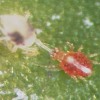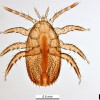 This predatory mite was recently discovered in an unsprayed greenhouse at the University of Florida, Gainesville, living on Phalaenopsis and Dendrobium orchids, and assumed to be feeding on orchid pests such as spider mites, tenuipalpid mites, and mealybugs that were present on the orchids. Because there was no published information on this species as a natural enemy of orchid pests, colonies were initiated here to study its biology, maintained on two-spotted spider mite prey. Hemicheyletia wellsina does not appear likely to be an effective natural enemy in agricultural crops as an introduced predator, but could be beneficial in natural biological control in natural ecosystems, where pest densities are lower. This 5-page fact sheet was written by Haleigh A. Ray and Marjorie A. Hoy, and published by the UF Department of Entomology and Nematology, December 2014. (Photo: Haleigh Ray, UF/IFAS)
This predatory mite was recently discovered in an unsprayed greenhouse at the University of Florida, Gainesville, living on Phalaenopsis and Dendrobium orchids, and assumed to be feeding on orchid pests such as spider mites, tenuipalpid mites, and mealybugs that were present on the orchids. Because there was no published information on this species as a natural enemy of orchid pests, colonies were initiated here to study its biology, maintained on two-spotted spider mite prey. Hemicheyletia wellsina does not appear likely to be an effective natural enemy in agricultural crops as an introduced predator, but could be beneficial in natural biological control in natural ecosystems, where pest densities are lower. This 5-page fact sheet was written by Haleigh A. Ray and Marjorie A. Hoy, and published by the UF Department of Entomology and Nematology, December 2014. (Photo: Haleigh Ray, UF/IFAS)
http://edis.ifas.ufl.edu/in1066
Tag: Acari (taxonomic order)
Tropilaelaps mite Tropilaelaps spp. Delfinado & Baker (Arachnida: Mesostigmata: Laelapidae)
 Honey bees throughout the world are exposed to numerous pests, parasites, and pathogens. One such parasite is Tropilaelaps spp. Delfinado & Baker, an ectoparasitic mite that feeds on the hemolymph of developing honey bees. Four species of Tropilaelaps have been identified and characterized. This 4-page fact sheet was written by Ashley N. Mortensen, Sarah Burleson, Gunasegaran Chelliah, Ken Johnson, Daniel R. Schmehl, and Jamie D. Ellis, and published by the UF Department of Entomology and Nematology, October 2014. (Photo credit: Pest and Diseases Image Library, Bugwood.org)
Honey bees throughout the world are exposed to numerous pests, parasites, and pathogens. One such parasite is Tropilaelaps spp. Delfinado & Baker, an ectoparasitic mite that feeds on the hemolymph of developing honey bees. Four species of Tropilaelaps have been identified and characterized. This 4-page fact sheet was written by Ashley N. Mortensen, Sarah Burleson, Gunasegaran Chelliah, Ken Johnson, Daniel R. Schmehl, and Jamie D. Ellis, and published by the UF Department of Entomology and Nematology, October 2014. (Photo credit: Pest and Diseases Image Library, Bugwood.org)
http://edis.ifas.ufl.edu/in1061
Eriophyid mite vector of Rose Rosette Disease (RRD) Phyllocoptes fructiphilus Keifer (Arachnida: Acari: Eriophyidae)
 Phyllocoptes fructiphilus Keifer, a tiny eriophyid mite, is the vector of a devastating viral disease of roses called Rose Rosette Disease (RRD). This mite can be spread by the wind and by contaminated clothing and equipment. It also is possible that it can disperse through phoresy (attaching itself to insects). As a result, the distribution of the mite and RRD is expanding. This 5-page fact sheet was written by Marjorie Hoy, and published by the UF Department of Entomology and Nematology, May 2013.
Phyllocoptes fructiphilus Keifer, a tiny eriophyid mite, is the vector of a devastating viral disease of roses called Rose Rosette Disease (RRD). This mite can be spread by the wind and by contaminated clothing and equipment. It also is possible that it can disperse through phoresy (attaching itself to insects). As a result, the distribution of the mite and RRD is expanding. This 5-page fact sheet was written by Marjorie Hoy, and published by the UF Department of Entomology and Nematology, May 2013.
http://edis.ifas.ufl.edu/in999
Swirski mite (suggested common name) Amblyseius swirskii Athias-Henriot (Arachnida: Mesostigmata: Phytoseiidae)
 Amblyseius is a beneficial predatory mite endemic to the Eastern Mediterranean region. This species is considered a generalist predator, and readily consumes small soft-bodied pest species as well as pollen or plant exudates. Amblyseius swirskii has attracted substantial interest as a biological control agent of mites, thrips and whiteflies in greenhouse and nursery crops and is currently reared and sold commercially in Europe and North America for this purpose. This 5-page fact sheet was written by Mahmut Dogramaci, Garima Kakkar, Vivek Kumar, Jianjun Chen, and Steven Arthurs, and published by the UF Department of Entomology and Nematology, June 2013.
Amblyseius is a beneficial predatory mite endemic to the Eastern Mediterranean region. This species is considered a generalist predator, and readily consumes small soft-bodied pest species as well as pollen or plant exudates. Amblyseius swirskii has attracted substantial interest as a biological control agent of mites, thrips and whiteflies in greenhouse and nursery crops and is currently reared and sold commercially in Europe and North America for this purpose. This 5-page fact sheet was written by Mahmut Dogramaci, Garima Kakkar, Vivek Kumar, Jianjun Chen, and Steven Arthurs, and published by the UF Department of Entomology and Nematology, June 2013.
http://edis.ifas.ufl.edu/in1001
Tropical Bont Tick Amblyomma variegatum Fabricius (Arachnida: Acari: Ixodidae) (EENY518/IN934)
 The tropical bont tick is considered one of the most detrimental of the tick species present in Africa and now the Caribbean. It can result in severe economic losses due to hide damage, milk production reduction, and death of livestock. This 7-page fact sheet was written by Karen C. Prine and Amanda C. Hodges, and published by the UF Department of Entomology and Nematology, June 2012.
The tropical bont tick is considered one of the most detrimental of the tick species present in Africa and now the Caribbean. It can result in severe economic losses due to hide damage, milk production reduction, and death of livestock. This 7-page fact sheet was written by Karen C. Prine and Amanda C. Hodges, and published by the UF Department of Entomology and Nematology, June 2012.
http://edis.ifas.ufl.edu/in934
EENY473/IN855 Varroa Mite, Varroa destructor Anderson and Trueman (Arachnida: Acari:Varroidae)
EENY473, an 8-page illustrated fact sheet by James D. Ellis and C. M. Zettel Nalen, is part of the Featured Creatures collection. It describes this devastating pest of Western honey bees — distribution, description, life cycle, economic importance, detection, and management. Includes references. Published by the UF Department of Entomology and Nematology, June 2010.
http://edis.ifas.ufl.edu/in855
EENY-443/IN781 American Dog Tick, Dermacentor variabilis (Say) (Arachnida: Ixodida: Ixodidae)
EENY-443, a 7-page fact sheet by Wai-Han Chan and Phillip E. Kaufman, is part of the Featured Creatures Collection. It describes this tick commonly found on dogs as an adult — its distribution, description, life cycle, seasonality, medical and veterinary importance, removal, and management. Includes references. Published by the UF Department of Entomology and Nematology, November 2008.
http://edis.ifas.ufl.edu/IN781
ENY-852/IN777 The Hibiscus Erineum Mite, Aceria hibisci (Acari: Eriophyidae) a New Introduction in the Caribbean and a Potential Threat to Florida’s Hibiscus
ENY-852, a 5-page illustrated fact sheet by Cal Welbourn, Jose Carlos Rodrigues and Jorge E. Peña, describes this mite pest of hibiscus recently confirmed in the Caribbean — symptoms and identification, dispersal, hosts and control. Includes references. Published by the UF Department of Entomology and Nematology, December 2008.
http://edis.ifas.ufl.edu/IN777